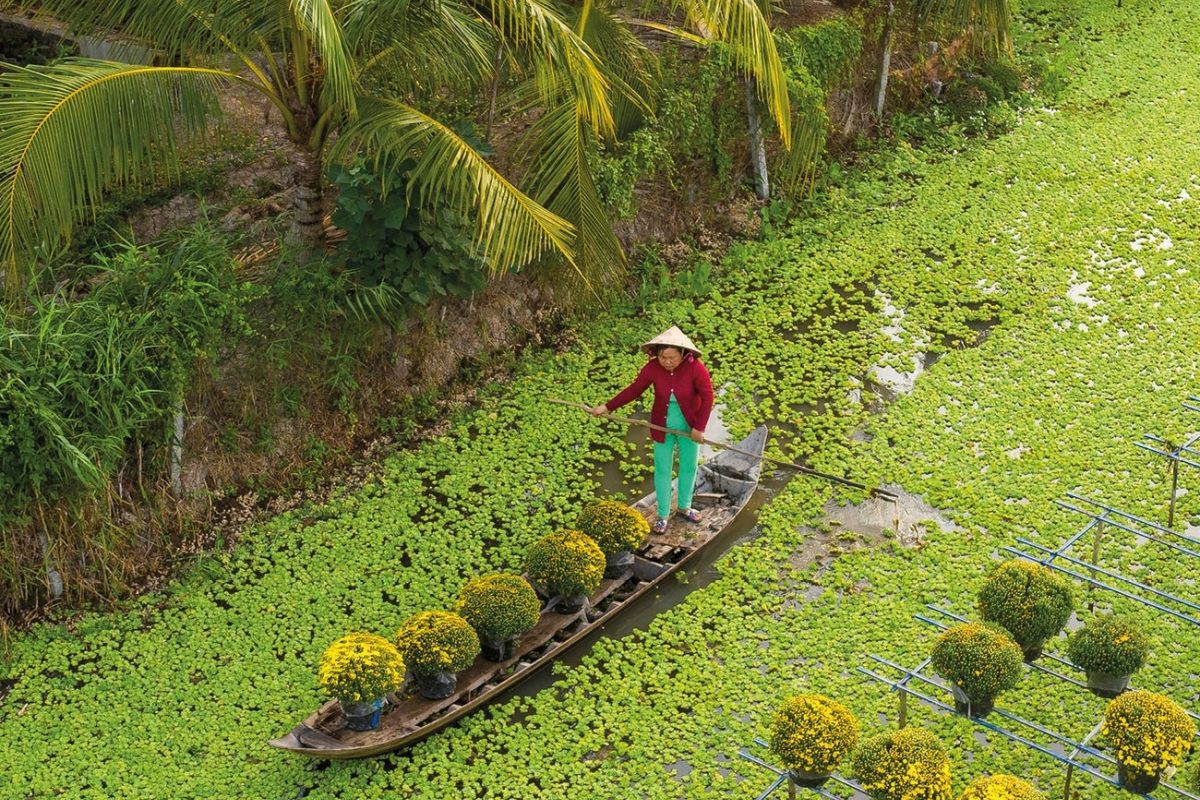TABLE OF CONTENT
Vietnam is a fairly easy place to visit, but when planning a trip, a common question is: How many days in Vietnam is enough? There is no exact answer to this question, however, Asia Encounter will suggest itineraries with different durations in Vietnam based on your needs and personal preferences, helping you easily choose and arrange your trip.

How many days in Vietnam is enough?
Determining the perfect duration for your trip depends on your interests, travel pace, and the regions you wish to explore. Vietnam’s diverse attractions can be enjoyed over a few days or several weeks, making it adaptable to all types of travelers.
- Short Break (3 to 5 days): This short break is ideal for experiencing some of Vietnam’s main attractions in the North, Central and South regions. Travelers should focus their experience on a single area, such as the vibrant cityscapes of Ho Chi Minh City or Hanoi.
- Medium Itinerary (7–10 days): A great option for first-time visitors to Vietnam who want more time to explore. This itinerary allows you to explore different regions of the country, including famous cities such as Hanoi, Hue, Hoi An and Ho Chi Minh City.
- Longer Itineraries (10–14 days or longer): Ideal for in-depth exploration of Vietnam’s culture, history and lesser-known locations such as Sapa, Ha Giang or the Mekong Delta.
How long to spend in Vietnam: Recommended Itineraries
3-5 Days: A Short Getaway
Day 1: Begin your journey in Hanoi, the capital of Vietnam. To get a feel for old Hanoi, famous for its bustling streets and ancient architecture, spend the day exploring the Old Quarter. After visiting Hoan Kiem Lake and Ngoc Son Temple, end the evening with a water puppet show, a traditional Vietnamese art form.
Day 2: Visit Ha Long Bay, a UNESCO World Heritage Site, during the day. While cruising through the emerald waters dotted with karst limestone formations, go kayaking, explore caves or relax on the deck.

Day 3: Return to Hanoi and visit the Temple of Literature, the first university in Vietnam, and the Ho Chi Minh Mausoleum. If you want to buy souvenirs with a strong Vietnamese flavor, explore the bustling Dong Xuan Market and learn how to bargain, which is also a typical cultural feature of the Vietnamese people.
How long in Vietnam in the south?
Day 1: Discover Ho Chi Minh City’s landmarks, including the War Remnants Museum and Notre Dame Cathedral.
Day 2: Take a day trip to the Cu Chi Tunnels, a historical site from the Vietnam War.
Day 3: Explore the Mekong Delta, famous for its floating markets and lush canals.
7-10 Days: A Medium Trip
Days 1-3: Begin your journey in northern Vietnam with two days to explore Hanoi, where you can learn about the rich history and culture of the Vietnamese people. On the third day, head to Ninh Binh, also known as Vietnam’s “Halong Bay on land”. Amidst the spectacular limestone karst landscape, take a boat trip to Tam Coc or Trang An to experience the natural beauty that nature has bestowed upon this region.
Days 4-5: Travel to central Vietnam on days four and five. On the first day in Hue, visit the Imperial Citadel and try the local specialties. The food in Hue is delicious and especially affordable, so visitors do not need to worry about the cost of food. Visit Hoi An on day five, you can take a boat trip on the lantern-lit Thu Bon River and visit Hoi An Ancient Town, which still retains its ancient beauty mixed with many different cultures.

Day 6-7: Spend the last two days in Da Nang, visiting the Marble Mountains and relaxing on My Khe Beach. Visit the famous Golden Bridge and Ba Na Hills for panoramic views at the end of the trip, if you wish.
10-14 Days: A Comprehensive Journey
Day 1-2: Your journey is started in Hanoi. Visit historical sites like the Temple of Literature, One Pillar Pagoda, and Ho Chi Minh Mausoleum while exploring the Old Quarter and sampling street food. Cruise to Ha Long Bay on day two to see limestone islands, caves and floating towns.
Day 3-4: Visit the charming mountain town of Sapa. Trek through rice terraces all day, stopping at ethnic minority communities such as Cat Cat or Ta Van for breathtaking views. Explore the bustling Sapa Market and take the cable car up Fansipan, Indochina’s highest peak, on day four.
Day 5-7: Fly to Hue and follow the central Vietnam itinerary mentioned above. Discover the Imperial City, cruise along the Perfume River, and enjoy authentic local dishes like bun bo Hue. Then, travel to Hoi An to immerse yourself in the town’s cultural charm and stunning beaches. Dedicate day seven to exploring Da Nang, as outlined in the medium trip itinerary.
Day 8-10: Fly south to Ho Chi Minh City. Spend the first-day visiting attractions such as the War Remnants Museum, Reunification Palace, and Ben Thanh Market. On day nine, explore the Cu Chi Tunnels and learn about their significance during the Vietnam War. Reserve day ten for a trip to the Mekong Delta, where you’ll enjoy boat rides through canals, visit floating markets, and sample fresh tropical fruits.

Day 11-12: Extend your Mekong Delta visit to explore deeper into the region. Visit traditional craft villages, take a sampan ride through lush waterways, and enjoy the serene countryside. Alternatively, head to Phu Quoc Island for pristine beaches, snorkeling, and luxury resorts.
Day 13-14: Wrap up your trip with additional exploration in Ho Chi Minh City or spend a relaxing day enjoying fine dining and boutique shopping. If in Phu Quoc, take a cable car ride over turquoise waters to Pineapple Island or unwind on the beach with a cocktail.
Best time to visit Vietnam
Vietnam’s weather varies significantly by region, making it a year-round destination. To decide how many days in Vietnam you should plan for, understanding the best times to visit is crucial. Northern Vietnam experiences cool winters and hot, humid summers. Spring (March to April) and autumn (September to November) are ideal for pleasant weather and scenic beauty.
While central Vietnam is mild for the most part, typhoons are common there from October to November. For sunny days and calm waters, visit between February and August. There are distinct wet and dry seasons in southern Vietnam due to its tropical climate. Outdoor experiences are ideal during the dry season, which lasts from November to April.

If you’re wondering how long in Vietnam is ideal, aligning your trip with your preferred weather conditions and planned activities is essential. Peach blossoms in Hanoi and the joyful Tet (Lunar New Year) festival are must-sees if you visit in the spring. While autumn brings beautiful rice fields in the north, summer brings vibrant beaches in Da Nang and Hoi An. The mild weather in the south makes winter an ideal time to explore.
How many days in Vietnam: Tips for first-time travelers
With so much to see in Vietnam, first-time visitors may have trouble deciding how long to spend in Vietnam. The following tips may help you plan your trip:
- Start with a clear itinerary: Determine your must-visit destinations and prioritize activities. If you’re short on time but still want to get the most out of your trip, consider traveling to specific regions of Vietnam.
- Pack wisely: Vietnam’s climate varies by season and region, so research the places you’ll be visiting and pack the most appropriate clothing. While breathable clothing is suitable for southern Vietnam, layers of clothing are best for northern Vietnam in winter.
- Travel lightly and efficiently: If you’re short on time, opt for flights between major cities like Hanoi, Da Nang, and Ho Chi Minh City. Trains and buses are better for extended trips, allowing you to see more of the countryside.
- Plan for cultural experiences: Allocate time for activities like cooking classes, lantern-making in Hoi An, or exploring ethnic villages in Sapa to gain a deeper appreciation for Vietnam’s traditions.
- Allow for rest days: Whether it’s relaxing on a beach or enjoying a coffee at a local café, include downtime in your itinerary to recharge.
By thoughtfully planning how many days in Vietnam to stay and where to go, you can create a seamless travel experience that captures the country’s diverse beauty and culture.
If you are fascinated by the beauty of Vietnam, don’t miss this exciting journey:
Whether you are looking for culinary delights, scenic beauty, or cultural immersion, Vietnam has something to suit every type of traveler. The answer to the question of “how many days in Vietnam” depends on your preferences, but even a short stay can create lifelong memories if planned well.
—
Let Asia Encounter help you create your ideal itinerary based on your requirements. We specialize in designing trips that highlight the best of Vietnam, whether it is in the bustling cities or the peaceful countryside. Your adventure awaits as you confidently explore Vietnam!




